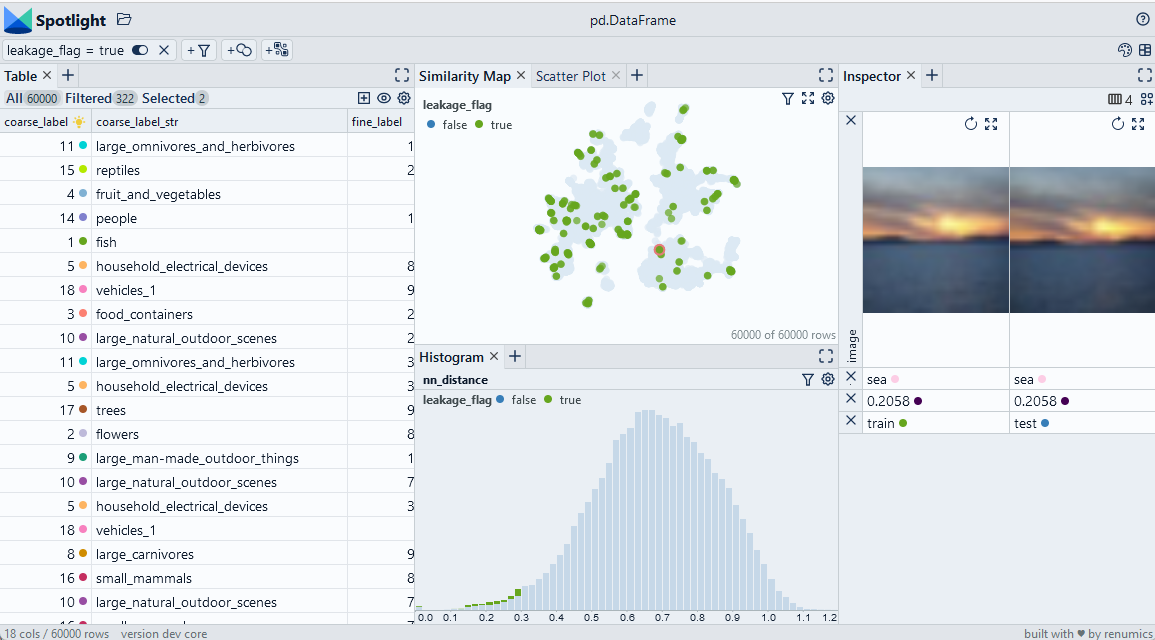Detect leakage with Annoy
We use embeddings to detect duplicates by computing nearest neighbors with the Annoy library. Then, we analyse those examples that leak from the training to the validation split. Although the example is based on image embeddings, the basic play is independent of the data type.
Use Chrome to run Spotlight in Colab. Due to Colab restrictions (e.g. no websocket support), the performance is limited. Run the notebook locally for the full Spotlight experience.
- inputs
- outputs
- parameters
df['nn_id']contains the sample id for the nearest neighbor in the embedding space.df['split']contains the name or numeric id for the split for each data sample.df['nn_distance']contains distance to the nearest neighbor.
df_leak['nn_same_split']contains a boolean flag if the data sample and its nearest neighbor is in the same split.df_leak['leakage_flag']contains a boolean flag if the the data sample is a candidate for leakage.
thresholddenotes the distance threshold when a data sample is considered a near-duplicate.

Imports and play as copy-n-paste functions
# Install dependencies
#@title Install required packages with PIP
!pip install renumics-spotlight datasets annoy
# Play as copy-n-paste functions
#@title Play as copy-n-paste functions
import datasets
from renumics import spotlight
from annoy import AnnoyIndex
import pandas as pd
import requests
def nearest_neighbor_annoy(df, embedding_name='embedding', threshold=0.3, tree_size=100):
embs = df[embedding_name]
t = AnnoyIndex(len(embs[0]), 'angular')
for idx, x in enumerate(embs):
t.add_item(idx, x)
t.build(tree_size)
images = df['image']
df_nn = pd.DataFrame()
nn_id = [t.get_nns_by_item(i,2)[1] for i in range(len(embs))]
df_nn['nn_id'] = nn_id
df_nn['nn_image'] = [images[i] for i in nn_id]
df_nn['nn_distance'] = [t.get_distance(i, nn_id[i]) for i in range(len(embs))]
df_nn['nn_flag'] = (df_nn.nn_distance < threshold)
return df_nn
def detect_leakage(df, nn_id_name='nn_id', split_name='split', threshold=0.3):
nn_id = df['nn_id']
split = split = df['split']
df_leak = pd.DataFrame()
df_leak['nn_same_split'] = [True if split[i]==split[nn_id[i]] else False for i in range(len(nn_id))]
df_leak['leakage_flag'] = (df.nn_distance < 0.3) & (df_leak['nn_same_split'] != True )
return df_leak
Step-by-step example on CIFAR-100
Load CIFAR-100 from Huggingface hub and convert it to Pandas dataframe
dataset = datasets.load_dataset("renumics/cifar100-enriched", split="train")
df = dataset.to_pandas()
Compute heuristics for data leakage based on nearest neighbor distance
df_nn = nearest_neighbor_annoy(df)
df = pd.concat([df, df_nn], axis=1)
df_leak = detect_leakage(df)
df = pd.concat([df, df_leak], axis=1)
Inspect and remove leakage with Spotlight
df_show = df.drop(columns=['embedding', 'probabilities'])
layout_url = "https://raw.githubusercontent.com/Renumics/spotlight/playbook_initial_draft/playbook/rookie/leakage_annoy.json"
response = requests.get(layout_url)
layout = spotlight.layout.nodes.Layout(**json.loads(response.text))
spotlight.show(df_show, dtype={"image": spotlight.Image, "embedding_reduced": spotlight.Embedding}, layout=layout)